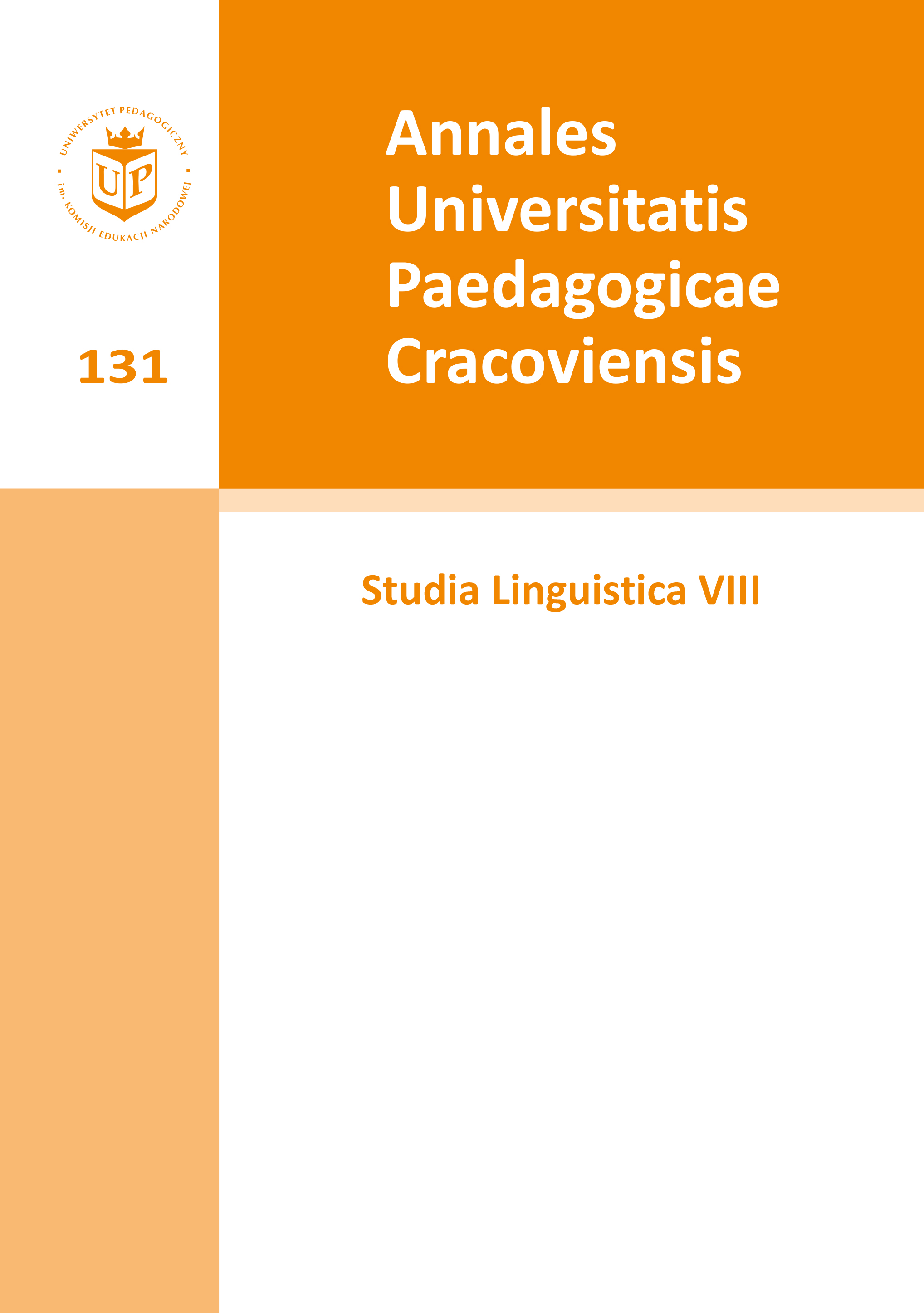Podziemny świat soli zawarty w leksyce legend górników wielickich
Main Article Content
Abstract
The article deals with the vocabulary used by the occupational group of the miners from Wieliczka. The world represented in the legends of the miners includes two spheres: real and fantastic. The real sphere consist of vocabulary that describes salt and its forms, the names of the mines and their elements, the names of places, tools, persons associated with salt mining, craftsmen and the workers employed in the mine as well as other names connected with the salt mine. The fantastic sphere includes the heroes of the legends of the miners from Wieliczka. The majority of the described names are formally diversified: in the analysed texts there are synthetic heroes and analytical forms that constitute the terminological concentrations such as: salt miner, white miner.
Downloads
Article Details
Author, submitting a text to the editorial board of the journal “Annales Universitatis Paedagogicae Cracoviensis. Studia Linguistica", certifies that the content of the article has not been published so far and that the work does not violate in any way the copyright or related rights of other person, as well as other rights of third parties, and that no one's rights to the work (or any part thereof) have been missed. After signing the contract, the property rights to the published materials are transferred to the Scientific Publisher of the University of the National Education Commission, Krakow.
“Annales Universitatis Paedagogicae Cracoviensis. Studia Linguistica” is an open access journal, and all its content is made available free of charge to users and institutions under the Creative Commons CC-BY-NC-ND 4.0 license (attribution, non-commercial use, no derivative works). Under this license, the authors agree that their work may be lawfully reused for any purpose, except for commercial purposes, without the prior consent of the author or publisher. Everyone can read, download, copy, print, distribute and process these works, provided that the author's marking and the original publication place are correct. Published texts may not be used to create derivative works (e.g. to translate and publish in another language without the consent of the publisher). This is in line with the BOAI (Budapest Open Access Initiative) definition. "Studia Linguistica" does not charge for submitting or processing articles.
References
Baluch A., 2009, Święta Kinga – wzorzec kulturowy, [w:] Kraków mityczny. Motywy, wątki, obrazy w utworach dla dzieci i młodzieży, red. A. Baluch, M. Chrobak, M. Rogoż, Kraków, s. 36–45.
Google Scholar
Burchard H., 1959, Eksploatacja soli w Polsce od XIII wieku, ,,Slavia Antiqua”, t. 6, s. 396–412.
Google Scholar
Ciszewski S., 1922, Studia etnologiczne. Sól, ,,Wisła”, t. 21, z. 1, s. 3–91.
Google Scholar
Dzieje żup krakowskich, 1988, red. A. Jodłowski, Wieliczka.
Google Scholar
Gajda S., 1976, Rozwój polskiej terminologii górniczej, Opole.
Google Scholar
Gaziński R., 2007, Prusy a handel solą w Rzeczypospolitej w latach 1772–1795, Warszawa.
Google Scholar
Hanik M., 1988, Wieliczka – siedem wieków polskiej soli, Warszawa.
Google Scholar
Janicka-Krzywda U., 1977, Demonologia Wieliczki i okolicy, ,,Studia i Materiały do Dziejów Żup Solnych w Polsce” (Wieliczka), t. 6, s. 134–140.
Google Scholar
Janicka-Krzywda U., 1979, Wierzenia górników wielickich, ,,Studia i Materiały do Dziejów Żup Solnych w Polsce” (Wieliczka), t. 8, s. 127–156.
Google Scholar
Keckowa A., 1958, ,,Bałwany” wielickie. Z badań nad historią górnictwa solnego w Polsce w XVII–XVIII wieku, ,,Kwartalnik Historii Kultury Materialnej”, t. 6, nr 4, s. 620–639.
Google Scholar
Keckowa A., 1969, Żupy krakowskie w XVI–XVIII w. (do 1772 r.), Wrocław – Warszawa – Kraków.
Google Scholar
Kopaliński W., 1990, Słownik symboli, Warszawa.
Google Scholar
Łeńska-Bąk K., 2002, Sól ziemi, Wrocław.
Google Scholar
Maślankiewicz K., 1961, Z przeszłości górnictwa solnego, ,,Przegląd Geologiczny”, t. 9, nr 11, s. 590–592.
Google Scholar
Maślankiewicz K., 1965, Z dziejów górnictwa solnego w Polsce, Warszawa.
Google Scholar
Osika J., 1930, Skarbnik, duch kopalni, ,,Orli Lot”, t. 11, nr 10, s. 171–173.
Google Scholar
Pełka L.J., 1987, Polska demonologia ludowa, Warszawa.
Google Scholar
Piotrowicz J., 1968, Problematyka genezy i najstarszych dziejów górnictwa solnego w Polsce, [w:] ,,Studia i Materiały do Dziejów Żup Solnych w Polsce” (Wieliczka), t. 2, s. 173–189.
Google Scholar
Ślizowski K., 2006, Kopalnie soli w Wieliczce i Bochni i ich znaczenie w dziejach regionu krakowskiego, [w:] Górnictwo w Małopolsce, Kraków, s. 159–172.
Google Scholar
Wyrozumski J., 1975, Sól, [w:] Słownik starożytności słowiańskich. Encyklopedyczny zarys kultury Słowian od czasów najdawniejszych do schyłku wieku XII, oprac. G. Labuda, Z. Stieber, Wrocław – Warszawa – Kraków – Gdańsk, s. 346–349.
Google Scholar
Zaleski W., 1993, Rok kościelny, t.2, Warszawa.
Google Scholar

